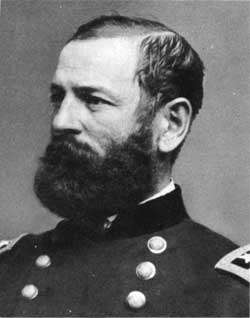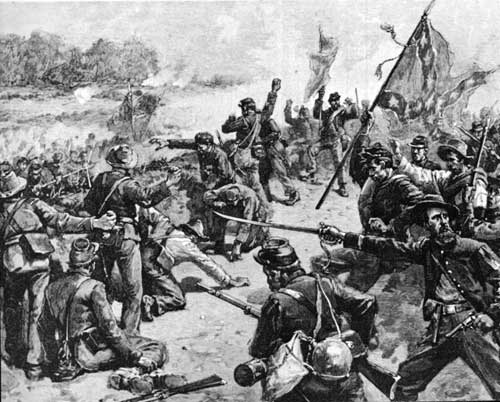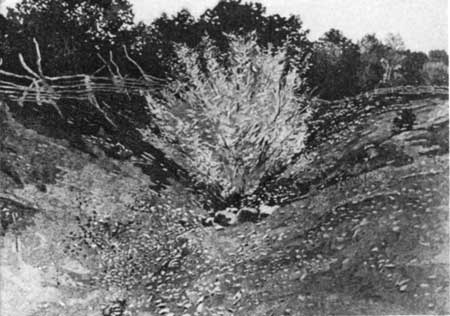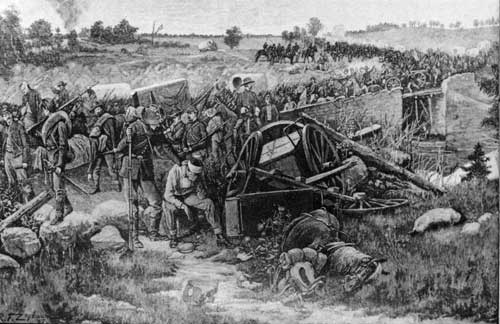|
MANASSAS National Battlefield Park |
 |
Second Battle of Manassas
THIRD PHASE—MAIN BATTLE, AUGUST 29-30. When Pope learned of the engagement of Groveton he mistakenly decided that King had met the head of Jackson's column in retreat. Confident of success, he ordered a concentration of his leg weary troops to crush the Confederate force. Sigel and Reynolds were to attack at dawn, reinforced by Heintzelman and Reno. McDowell and Porter were ordered to reverse their course and push toward Gainesville in an effort to cut off Jackson's retreat.
The text of this order known as the "Joint Order," which was received about noon, reads as follows:
HEADQUARTERS ARMY OF VIRGINIA
Centreville, August 29, 1862.Generals McDowell and Porter:
You will please move forward with your joint commands toward Gainesville. I sent General Porter written orders to that effect an hour and a half ago. Heintzelman, Sigel, and Reno are moving on the War renton turnpike, and must now be not far from Gainesville. I desire that as soon as communication is established between this force and your own the whole command shall halt. It may be necessary to fall back behind Bull Run at Centreville to-night. I presume it will be so, on account of our supplies. . . .
If any considerable advantages are to be gained by departing from this order it will not be strictly carried out. One thing must be had in view, that the troops must occupy a position from which they can reach Bull Run to-night or by morning. The indications are that the whole force of the enemy is moving in this direction at a pace that will bring them here by to-morrow night or the next day. My own headquarters will be for the present with Heintzelman's corps or at this place.
Jno. Pope,
Major-General, Commanding.
 Maj. Gen. Fitz-John Porter, in command of the Fifth Army Corps at the Second Battle of Manassas. Courtesy Library of Congress. |
Prior to the receipt of the "Joint Order," Porter had reversed his course to Centreville and had moved as far as Dawkin's Branch, located about 3 miles from Gainesville. Finding the Confederates strongly posted in his front, he deployed a brigade of his leading division and waited. McDowell, who arrived shortly thereafter, showed him a dispatch he had received a few minutes before from Buford, who commanded the Union cavalry on the right. The dispatch stated that 17 regiments, 1 battery, and 500 cavalry had passed through Gainesville about 8:45 a. m. This was the advance of Longstreet's command which had left Thoroughfare Gap early that morning and now, followed by heavy reinforcements, was moving into position on Jackson's right (Porter's front).
This information, the generals felt, had not reached Pope. After a conference, it was decided that in face of this new development they would take advantage of the latitude the order granted: McDowell would move towards Groveton, while Porter would remain in the vicinity of his present position.
The relative quiet in this sector was in sharp contrast to the heavy fighting now taking place along Jackson's front. With about 18,000 infantry and 40 guns, Jackson had taken up a position along an unfinished railroad bed which extended from near Sudley Springs 2 miles south westerly to Groveton. The grades and cuts of this road provided ready-made entrenchments and formed a very strong position. There, shortly after sunrise, Sigel's and Reynolds' columns were seen at a distance deploying for the attack. About 7 a. m., the Federal batteries opened fire. By 10:30 a. m., a number of sharp skirmishes had taken place, but no general assault had been made. About this time Federal reinforcements of Reno and Kearny reached the field. It was not until 2 p. m., however, that the battle reached its height. All afternoon in violent but uncoordinated attacks, blue columns gallantly assaulted Jackson's line. At one point the Confederate left was pushed back dangerously near the breaking point, but the gray line steadied and held. Towards dusk, King's division, of McDowell's corps, arrived in time to take part in the action, engaging a part of Longstreet's command which was then advancing on a reconnaissance.
Pope, still unaware of the arrival of Longstreet on the field, late in the day sent Porter the following order to attack Jackson's right at once:
HEADQUARTERS IN THE FIELD,
August 29—4:30 p. m.Major-General Porter:
Your line of march brings you in on the enemy's right flank. I desire you to push forward into action at once on the enemy's flank, and, if possible, on his rear, keeping your right in communication with General Reynolds. The enemy is massed in the woods in front of us, but can be shelled out as soon as you engage their flank. Keep heavy re serves and use your batteries, keeping well closed to your right all the time. In case you are obliged to fall back, do so to your right and rear, so as to keep you in close communication with the right wing.
John Pope,
Major-General, Commanding.
This order, dated 4:30 p. m., was received by Porter at Bethlehem Church about 6:30 p. m. Upon receipt of the order Porter immediately sent his chief of staff, Locke, to order Morell's division to attack. Shortly thereafter Porter rode to the front to find Morell's preparations for the attack complete. By this time, however, it was so late that Porter decided to rescind the order.1
During the night the Confederates retired from the advanced positions gained during the day to their original battleline. This fact was reported from the field early on the morning of the 30th and later confirmed by a reconnaissance by McDowell and Heintzelman. This led Pope falsely to assume that Lee was in retreat to Thoroughfare Gap. Immediately, plans were initiated to press a vigorous pursuit. At midday the following order was issued:
| Special Orders, No. — |
HEADQUARTERS NEAR GROVETON, August 30, 1862—12 M. |
The following forces will be immediately thrown forward and in pursuit of the enemy, and press him vigorously during the whole day. Major-General McDowell is assigned to the command of the pursuit.
Major-General Porter's corps will push forward on the Warrenton turnpike, followed by the divisions of Brigadier-Generals King and Reynolds. The division of Brigadier-General Ricketts will pursue the Hay Market road, followed by the corps of Major-General Heintzelman. . . .
At 3 a. m. of the 30th, Porter received Pope's dispatch ordering him to march his command immediately to the field of battle of the previous day. In compliance with this order he promptly withdrew from his position facing Longstreet and marched rapidly along the Sudley Road to the center of the battlefield where he reported to Pope for orders. Though this movement strengthened the center, it dangerously weakened the Federal left.
From its contracted left near Groveton, the Federal line now extended approximately 3 miles to Bull Run near Sudley Church. The opposing Confederate line was about 4 miles long. Jackson held the left along the unfinished railroad, while Longstreet held the right, with the main body of his troops "bent to the front" south of the Warrenton Pike. A heavy concentration of artillery was placed on high ground between the two wings. These guns commanded the open fields and the stretch of woods near Jackson's right and center.
Preparations completed about midafternoon, the Federal columns of Porter and Heintzelman advanced three lines deep, preceded by a swarm of skirmishers and supported by great masses of men and guns in the rear. A strange quiet pervaded the fields as the unsuspecting troops pushed forward. Behind their protective cover, the Confederates watched the lines draw closer; then suddenly opened upon them a rapid artillery fire. Instantly, the infantry bugles sounded the alarm alerting Jackson's men to action. The Federal advance line halted and staggered back. Other brigades quickly pushed forward only to be broken by the raking force of the fire.

Some of Jackson's Confederates, their ammunition
exhausted, hurling rocks at the advancing Federals, during the Second
Battle of Manassas.
From " "Battles and Leaders of the Civil
War."
Soon it was apparent that the main Federal assault was being directed by Porter and Hatch against Jackson's right and center held by the divisions of Starke and Lawton. In gallant style, a third line moved up and impetuously pressed the attack. The force of this forward movement pushed back the famous Stonewall brigade, but later it reestablished its lines in a desperate countercharge. Heavy fighting at close quarters now ensued. At one point in their line near a section of the railroad bed known as the "Deep Cut," Jackson's veterans, with ammunition exhausted, partially repelled an attack with stones from the embankment.

The "Deep Cut" where Porter's troops made a
gallant bid for victory. Here a Federal flag held its position for half
an hour within 10 yards of a Confederate regimental flag. Six times it
fell, only to be raised again.
From "Battles and Leaders of the
Civil War."
Finally, the pressure became so great that Jackson sent an urgent request for reinforcements. Lee then ordered forward a brigade from Longstreet's command. Anticipating the request, Longstreet had already moved up the batteries of Stephen D. Lee, which now opened a withering fire on the Federal columns on Jackson's right and center. The effect was devastating. Within 15 minutes the whole aspect of the battle had changed.
Shortly after the Federal brigades had engaged Jackson along the unfinished railroad, Pope had ordered Reynolds' division from his left at Bald Hill to move up and support the attack on the right. The weight of his numbers, however, proved insufficient to stem the tide of retreat that had now set in. Quickly, Jackson ordered up two brigades to press a counterattack, moving forward his artillery as the infantry advanced.
The transfer of Reynolds' division had again greatly weakened the Federal left. Lee saw this and realized that here at last was the opportunity for which he had been waiting. The order was sent immediately to Longstreet to deliver the counterstroke. Every regiment, battery, and squadron of both wings of the army were to be employed. By sheer weight of numbers the attack was to be driven home in successive waves of assault, piling one upon the other.
Again, Longstreet had anticipated the order for which he had been preparing since dawn. The long gray lines of infantry, restive for the fray, now swept forward in a furious assault. In advance came Hood's Texans, their colors gleaming red in the evening sun. Above the thunderous roar of artillery and the noise of battle could be heard the shrill cries of the rebel yell echoing through the Groveton valley. So intense was the excitement that only with the greatest difficulty could the officers restrain their men. Rapidly moving up in support came the divisions of Anderson, Kemper, and D. R. Jones. Across the rolling fields the attack pushed to gain the promontory of Chinn Ridge despite a stubborn defense by the Union brigades of McLean, Tower, and Milroy, while Jackson's veterans successfully assailed Buck Hill.

The Federal retreat over the Stone Bridge on
Saturday evening, August 30, 1862.
From "Battles and Leaders of the
Civil War."
On Henry Hill, poignant with memories of the previous year, were now assembled Reynolds' divisions, Sykes' regulars, and other available troops. With courage and gallantry that matched the crisis of battle, they hurled back repeated Confederate assaults that continued until dark. The successful defense of Henry Hill made possible Pope's retreat over Bull Run, by the Stone Bridge and other fords, to the strong defenses of the Centreville plateau.
1 For his failure to carry our Pope's order of the 29th to attack Jackson, Porter was court-martialed and dismissed from the army on January 21, 1863. In 1879, a board of general officers who reviewed the case held that Porter could not have attacked Jackson successfully, as ordered, because Longstreet's corps had moved up into position on the right of Jackson and opposite Porter, and that this was known to the latter. Thus, Pope's order, which was written without knowledge of this development, could not be carried out. President Arthur, in 1882, remitted that part of the sentence which disqualified Porter from holding any office of trust or profit under the Government of the United States. On August 5, 1886, Porter was reappointed colonel of infantry, and 2 days later placed on the retirement list, To this day, despite his final vindication, the controversy over Porter's action on August 29, 1862, at Second Manassas has nor died down among military students.

|

|
|
Last Modified: Sat, Apr 7 2001 10:00:00 am PDT |


